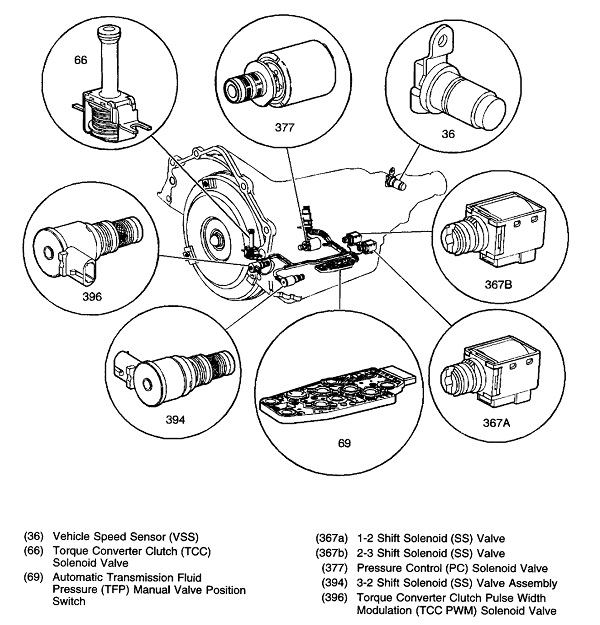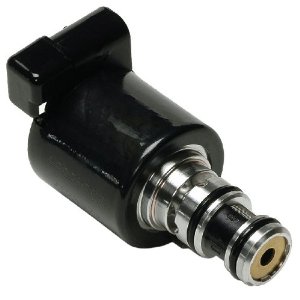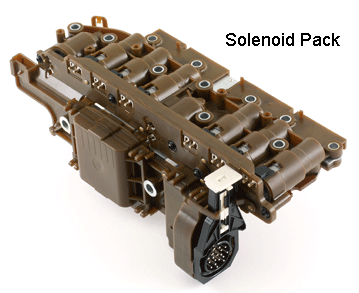Modern automatic transmissions use pressurized hydraulic fluid to change gears. Every time a gear change is required, the car’s computer activates a transmission solenoid, which directs transmission fluid into the valve body to engage the correct gear. If one of these electro-mechanical valves fail, then all sorts of transmission problems can ensue. So let’s take a closer look at the shift solenoid, and the common problems associated with it.
What Transmission Do I Have?

How Does a Transmission Solenoid Work?
As you’re going down the road, the car’s computer analyzes data being sent by vehicle speed sensors and engine speed sensors. Based on this information, the Engine Control Unit (ECU), or the Transmission Control Unit (TCM), executes the appropriate upshift / downshift by sending a signal to one of several shift solenoids. These transmission solenoids have a spring-loaded plunger inside, which are wrapped with wire. When this coil of wire receives an electrical charge from the TCM / ECU, it causes the plunger to open, allowing transmission fluid to flow into the valve body and pressurize the desired clutches and bands. When this happens, the transmission changes gears and you continue down the road.
The car’s computer can control the transmission solenoid in several ways. If the vehicle is equipped with a dedicated Transmission Control Unit, it can open or close the hydraulic circuit using a direct 12v signal. Or, the Engine Control Unit can control the solenoid’s plunger by turning the ground circuit on and off. A solenoid can be used to control a single gear or multiple gears, depending upon the complexity of the design.

Symptoms of a Transmission Solenoid Problem
 A transmission solenoid can fail due to electrical issues, or dirty fluid that’s caused the shift solenoid to become stuck open / closed. Any change in the transmission fluid pressure can cause numerous problems, including:
A transmission solenoid can fail due to electrical issues, or dirty fluid that’s caused the shift solenoid to become stuck open / closed. Any change in the transmission fluid pressure can cause numerous problems, including:
Erratic Shifting – If you’re dealing with a failed transmission solenoid, the gearbox can skip a gear up or down, shift back and forth between gears repeatedly, or get stuck in a gear and refuse to shift.
Transmission Won’t Downshift – If the transmission will not downshift, one of the shift solenoids may have become stuck open / closed, preventing fluid from entering the transmission valve body to pressurize the correct gear.
Severe Shifting Delay / Stuck in Neutral – In order for an electronically controlled automatic transmission to shift gears, the solenoid must be able to regulate the fluid pressure to activate the appropriate gear. If the shift solenoid is receiving too much or too little electric current, or dirty transmission fluid has caused it to become stuck open / closed, gear engagement maybe become difficult or delayed, which can cause the transmission to act as if it is temporarily locked in neutral.
Because the solenoids are connected to a vehicle’s electrical system, the ECU will usually register an error code and trigger the check engine light if something goes wrong. If this happens, the transmission can go into limp / fail mode, where it will only engage second / third gear to limit the vehicle speed without immobilizing it.
The first thing that your mechanic should look at are the error codes. Using a scan tool, the technician can determine the source of the solenoid’s problem. It could be as simple as a bad ground, or as complex as a failed solenoid pack (a grouping of individual shift solenoids).
Transmission Solenoid Replacement Cost – Parts & Labor
In most cases, solenoids are located inside of the oil pan, connected to the valve body. Depending on what you drive, the technician may be able to replace just the failed shift solenoid. However in some cases, the solenoids come in these multiple unit packs so if there is a problem with one, the entire pack must be replaced. This job typically takes 2-4 hours to complete, and shop time is generally billed at $60 – $100 per hour. The average total cost to diagnose and replace one ranges between $150 and $400.
Depending on the make and model of your vehicle, expect to pay between $15 – $100 for a single transmission shift solenoid. A pack can cost $50 to $300.
| Type | Cost Range |
|---|---|
| Single | $15 to $100 |
| Pack | $50 to $300 |
| Labor | $120 to $400 |
| Total (Pack) | $250 to $600 |

Although it isn’t unusual for transmission shift solenoids to wear out over time, you can extend their life by changing your transmission fluid at the factory recommended intervals. This will clean out all of the dirt and sludge that builds up, and the fresh fluid will keep the plungers on the inside of the solenoids from sticking. If you don’t know what your vehicle’s recommended transmission service intervals are, check the back of your owner’s manual, or simply ask Google.
Get a great deal on a replacement solenoid – for as low as $11 on Amazon <

I have a 2017 Toyota Corolla LE. In September 2023 I had the transmission fluid changed at an AAMCO station. Subsequently I had a whining noise coming from the transmission on startup. The vehicle would vibrate and lose acceleration if I did not wait until the whining noise stopped. The station that did the flush accepted no responsibility for the condition. Therefore I took it to another AAMCO station for a second opinion. They could find no solution to the problem. I then took the vehicle to a Toyota dealership in VA. They had no solution accept “buy a new transmission”. Then I took the vehicle to another Toyota dealership in MD. I got the exact same result. The exact same result, which was “buy a new transmission”. Now the fact is that after driving the car for a few miles the vibration dissipates and the vehicle runs perfectly. That is why I am adamite about pursuing someone who can identify the problem. Now, the specific symptoms are: (1) whining noise on startup resulting in no transmission pressure to accelerate until whining noise dissipates (2) When temperature is below freezing I cannot get a gear until the engine warms up and the whining noise starts, which takes about 10 minutes. However, in this case, whining noise would not be as loud or lengthy. I can pull right out. Seems as if the pressure in the transmission builds up during the wait. Since the PRO’S could not help me I decided to get a simple scan on the vehicle. I got a primary code P0841 and a list of secondary codes pertaining to sensors and switches. Are these sensors or switches inside the transmission? According to the information that I have provided can you come up with a possible diagnosis?
I change the solenoid on my Chevy equinox 2009 and it’s still doing the erotic shifting my RPMs sometimes change gears and then sometimes it doesn’t. What is the problem now???
I have a 97 Dodge Caravan Le and we had a transmission leak coming from the solenoid pack so our mechanic first took the old pack apart and tried to fix it and put it back on, it wouldn’t shift properly so we bought a new solenoid pack and it’s still the same, shifts for a few minutes but when you come to a stop it won’t shift from high gear.
DTC incorrect ratio gears 2 and 4. sensor switch circuits A and C
Mechanic put a new control solenoid on it and it shifts but when you stop it won’t shift out of high gear.
my truck is stuck in park